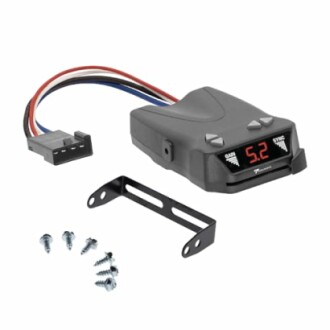
How to Choose the Right Brake Controller for Your Vehicle
Key Takeaways
- Understand the different types of brake controllers: time-delayed and proportional.
- Check your vehicle's compatibility with the brake controller.
- Consider ease of installation and user-friendly features.
- Evaluate your towing needs based on load weight and frequency of towing.
- Review digital features for better diagnostics and control.
Choosing the right brake controller is crucial for safe and effective towing. Whether you're hauling a trailer for work or weekend adventures, a brake controller ensures your vehicle and trailer stop safely together. This guide outlines what to look for when selecting a brake controller to fit your specific vehicle and towing needs.
Understanding Brake Controllers
Brake controllers can be broadly categorized into two main types: time-delayed and proportional. Each type has its unique features and benefits.
| Brake Controller Type | Description | Ideal Use Cases |
|---|---|---|
| Time-Delayed | Applies braking power gradually over a set period. | Basic or light-duty towing needs. |
| Proportional | Synchronizes braking with the vehicle's braking actions. | Heavy-duty or frequent towing with varying loads. |
Compatibility with Your Vehicle
Not all brake controllers work with every vehicle. When choosing a brake controller, make sure to:
- Check your vehicle manufacturer's specifications.
- Look for harness compatibility (some controllers might require a specific wiring harness).
Installing Your Brake Controller
Most modern brake controllers are designed for easy installation. Here’s what to consider:
Tips for Installation
- Choose a location that’s easily accessible while driving.
- Familiarize yourself with the manufacturer's instructions.
- Use a Plug & Play port if available for a quicker setup.
Evaluating Your Towing Needs
Before purchasing a brake controller, evaluate:
- Your vehicle's towing capacity.
- The weight of the trailer you plan to tow.
- Frequency of towing and varying load conditions.
Product Highlight
For those who are looking for a reliable brake controller, we recommend the Tekonsha Brakeman IV. Here’s a closer look:
Tekonsha 8507120 Brakeman IV
The Tekonsha Brakeman IV features easy installation with its Plug & Play port and a user-friendly digital display for diagnostics, ensuring safe and controlled towing.
Learn MoreDigital Features to Consider
Modern brake controllers come equipped with digital displays that provide real-time diagnostics. Consider the following:
- Digital readouts for setting adjustments and power levels.
- Indicators for secure connections and braking diagnostics.
- Manual control features for added safety when needed.
Pros and Cons of Brake Controllers
Pros
- Enhanced safety while towing.
- Transferable between vehicles with minimal adjustments.
- Variety of features to suit different towing applications.
Cons
- Compatibility issues with some vehicle models.
- May require additional wiring kits or adapters.
- User-friendliness can vary between models.
Conclusion
Choosing the right brake controller is essential for safe towing. By understanding the different types of brake controllers, evaluating your vehicle’s compatibility, and assessing your towing needs, you can make an informed decision.
For more expert guidance and reviews, check out our Buying Guides to explore other products for your towing and transportation needs.
Remember, a well-chosen brake controller can make all the difference on the road, ensuring both safety and peace of mind while you tow.

